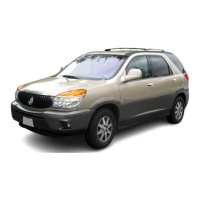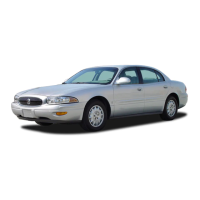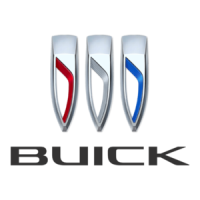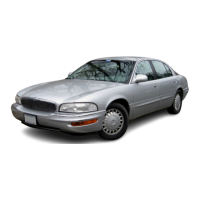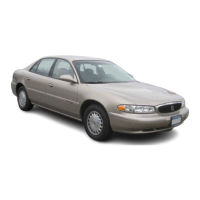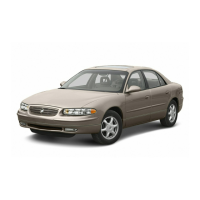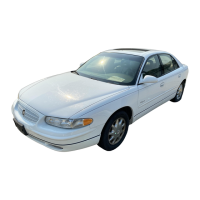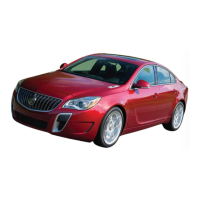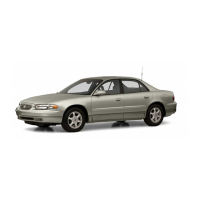
Do you have a question about the Buick 2002 Regal and is the answer not in the manual?
| Brand | Buick |
|---|---|
| Model | 2002 Regal |
| Category | Automobile |
| Language | English |
Explains cautions and symbols used for safety warnings in the manual.
Explains symbols used to indicate warnings or information about vehicle components.
Information on adjusting seats and head restraints.
How to use safety belts properly and what not to do.
FAQ addressing common questions about safety belt usage and effectiveness.
Detailed instructions on how to wear safety belts correctly.
Describes the driver's restraint system and proper seating position.
Guidance on safe safety belt usage for pregnant women.
Explains the frontal and side impact air bag systems.
Importance and proper usage of safety belts for rear seat occupants.
Information on operating power windows and express-down features.
Details about ignition and door keys, and importance of having extra keys.
Explains manual and power door lock operation, including programmable modes.
How to use the remote to lock, unlock, and activate panic alarm.
Information on trunk locks, remote release, and assist handles.
Tips on preventing vehicle theft, including key-in-ignition and parking strategies.
Details the passive theft-deterrent system and troubleshooting for ignition key issues.
Guidelines for breaking in a new vehicle, including driving and braking recommendations.
Explanation of the five ignition key positions and retained accessory power.
Steps for starting the engine and important notices regarding starter motor and battery.
Benefits and usage of the engine coolant heater in cold weather.
Explanation of shift lever positions, PARK (P) engagement, and shift lock control.
Instructions for setting and releasing the parking brake.
Steps for safely shifting into PARK (P) and avoiding torque lock.
Cautions and procedures for leaving the vehicle with the engine running.
Procedures for shifting out of PARK (P), including shift lock release.
Warning about parking over flammable materials due to hot exhaust parts.
Information and cautions regarding engine exhaust and carbon monoxide.
Advice and cautions for idling the engine.
How to use the horn symbols on the steering wheel.
How to adjust the steering wheel using the tilt lever.
Controls for turn signals, headlamps, wipers, and cruise control.
How to switch between high and low beams using the lever.
How to use high beams to signal a driver ahead.
Operation of wipers, including mist, low, high, and delayed settings.
How to use the windshield washer fluid and a caution about freezing weather.
How to set, resume, increase, and decrease speed using cruise control.
Operation of exterior lamps, including parking and headlamps.
Functionality of DRLs and automatic headlamp activation.
Feature providing exterior lighting when leaving the vehicle.
How to turn fog lamps on and off, and their interaction with headlamps.
How cornering lamps activate when signaling a turn.
Controls for instrument panel brightness and courtesy lamps.
Courtesy lamps activating upon remote unlock or door opening.
Interior lighting that stays on for a period after doors are closed.
Interior lighting that stays on for a period after the ignition key is removed.
Exterior lighting activated when approaching the vehicle.
How to operate reading lamps located on the rearview mirror.
Dome lamp activation when a door is opened.
Feature that automatically turns off interior lamps to prevent battery drain.
Adjusting interior and exterior mirrors, including day/night and power foldaway features.
Mirror that darkens to reduce glare from headlamps.
Mirror with automatic dimming, OnStar, and map lamp features.
Using controls to adjust power outside mirrors and their foldaway function.
Information about passenger side convex mirrors and a caution about judging distance.
Driver's side mirror adjusts for glare and can be heated.
Details on glove box, center console, and rear storage armrest compartments.
How to use and store the convenience net in the trunk.
Location and use of ashtrays and the cigarette lighter.
How to use sun visors and their extenders.
Operation of lighted vanity mirrors.
How to use the 12-volt outlet for accessory power.
Feature providing power and wires for aftermarket electrical equipment.
Overview of OnStar services, buttons, and cellular antenna.
Operation of the express-open sunroof, including vent and close functions.
Overview of instrument panel components and their functions.
Explanation of the instrument panel cluster, gauges, and indicators.
How to read speed, mileage, and trip odometer functions.
Explanation of the tachometer display for engine speed.
Describes various warning lights and gages that signal vehicle issues.
Function of the safety belt reminder light and chime.
Indicates the status of the air bag system and potential malfunctions.
What the charging system light indicates and actions to take.
Indicates brake system problems and necessary actions.
What the ABS warning light signifies and troubleshooting steps.
Reasons for the traction control warning light and system operation.
Indicates when the traction control system is limiting wheel spin.
Indicates engine coolant overheating or cooling fan issues.
How to read the engine coolant temperature gage.
Indicates low engine oil level requiring immediate attention.
Alert for significant changes in tire pressure.
Indicates potential problems with fuel, ignition, or emission control systems.
Warns of low oil pressure, indicating potential engine damage.
Indicates low engine oil level requiring immediate attention.
Indicates when engine oil and filter change is recommended.
Indicates the status of the PASS-Key II theft-deterrent system.
Indicates when the cruise control system is engaged.
Displays safety and maintenance information, including fuel economy and range.
Describes the buttons used to control the Driver Information Center functions.
Explains the different display modes available in the Driver Information Center.
Overview of climate control system operation.
System allows separate driver and passenger temperature control.
Controls airflow direction for various modes like MAX, VENT, BI-LEV, HTR, BLEND, DEF.
Button to turn the air conditioning (A/C) on and off.
Automatic climate control allowing manual adjustments.
Manually controlling airflow direction, fan speed, and air recirculation.
Settings for clearing front and side windows quickly.
How to turn the rear window defogger on and off.
Adjusting airflow direction and tips for ventilation.
General information about operating the audio system.
How to set the clock on the audio system.
Operation of the AM-FM stereo, cassette player, and auto tone control.
How to turn the radio on/off, adjust volume, and recall stations.
Methods for finding radio stations using TUNE, SEEK, P SCAN, and AUTO SET.
How to set favorite radio stations on pushbuttons.
Adjusting bass, treble, and using tone presets for EQ.
How to adjust speaker balance and fade.
Instructions for inserting, playing, and controlling cassette tapes.
Explains error messages and troubleshooting for the cassette player.
Instructions for inserting, playing, and controlling compact discs.
Explains error messages and troubleshooting for the CD player.
How to activate and unlock the radio's theft-deterrent system.
Operating radio functions from the steering wheel.
Factors affecting AM and FM radio reception and tips for improving it.
Precautions for safe listening volumes to prevent hearing damage.
Recommended cleaning procedures for the cassette player.
Proper handling and storage of compact discs.
Advice against using CD lens cleaner discs due to potential damage.
Information about the AM-FM antenna integrated into the rear window.
Location and function of AM-FM antennas in front and rear windows.
Best advice on driving defensively, expecting the unexpected, and maintaining focus.
Dangers of drinking and driving, and factors affecting Blood Alcohol Concentration (BAC).
Systems controlling vehicle movement (brakes, steering, accelerator) and losing control.
Explanation of perception and reaction time in braking, and stopping distances.
How ABS works to prevent skids and what the warning light indicates.
System that limits wheel spin, especially in slippery conditions.
How the traction control system operates and limits wheel spin.
Information on power steering and magnetic speed variable assist steering.
Advice on driving on curves and steering in emergencies.
How to recover if vehicle wheels drop off the road onto the shoulder.
Tips for safely passing other vehicles on two-lane highways.
What happens when control systems fail due to lack of friction.
Types of skids (braking, steering, acceleration) and how to avoid them.
Tips for safer night driving, including visibility and driver impairment.
Advice for driving in wet conditions, including hydroplaning and wiper care.
Explanation of hydroplaning and factors that contribute to it.
Safety tips for city driving, managing traffic and signals.
Rules and advice for safe freeway driving, including merging and lane changes.
Checklist for preparing your vehicle and yourself for long trips.
Awareness and prevention of driver fatigue and loss of focus on highways.
Tips for driving safely on steep hills and mountains, including braking and engine use.
Tips for winter driving, including vehicle preparation and emergency supplies.
Advice for driving on slippery surfaces and maintaining traction.
What to do if stranded in a blizzard, including safety measures.
Information on towing vehicles behind recreational vehicles.
Warning against dinghy towing due to potential damage to drivetrain components.
Steps involved in towing the vehicle using a dolly.
Information on vehicle weight limits, capacity labels, and proper loading.
General advice and requirements for safely towing a trailer.
Importance of maintaining adequate following distance when towing.
Increased distance needed for passing when towing a trailer.
How to back up a vehicle with a trailer attached.
Advice on making wider turns to avoid trailer contact with the vehicle.
Importance of checking trailer lights and turn signals when towing.
Shifting to lower gears for downhill braking and uphill climbing when towing.
Steps to safely park a vehicle with a trailer on a hill.
How to use hazard flashers to warn others and signal a problem.
Using reflective triangles as a warning device behind the vehicle.
Safe procedures for jump starting a vehicle with a dead battery.
When to consult a dealer or professional service for towing.
Identifying engine overheating through gages, lights, and steam.
Emergency mode that limits power to prevent engine damage during overheating.
Cautions and actions to take if steam is observed coming from the engine.
Steps to take if overheating occurs without visible steam.
Overview of cooling system components and checks, including coolant level.
Procedure for adding coolant to the recovery tank.
Procedure for adding coolant directly to the radiator.
Information on the radiator pressure cap and its importance.
What to do if a tire experiences a blowout or slow leak.
Steps for safely changing a flat tire, including vehicle preparation.
How to access and remove the spare tire and jacking equipment from the trunk.
How to remove wheel center caps using the provided wrench.
Steps for removing wheel covers and loosening wheel nuts.
Steps for removing the flat tire and installing the spare tire.
Procedures for storing the flat tire and tools safely.
How to store the compact spare tire and associated tools.
Information on the compact spare tire, its pressure, usage, and calibration.
Techniques for freeing a stuck vehicle, including "rocking" and cautions.
Step-by-step guide on the "rocking" method to free a stuck vehicle.
General advice on cleaning products and their potential hazards.
Using a vacuum and damp cloth for cleaning interior surfaces.
Tips for cleaning fabric and carpet, including stain removal.
Step-by-step guide for applying cleaner to fabric surfaces.
Methods for removing specific stains like catsup, vomit, and blood.
How to clean vinyl surfaces using warm water and cleaners.
Proper methods for cleaning leather seats and surfaces.
Using mild soap and water to clean the instrument panel surfaces.
Cleaning interior plastic with mild soap and water.
Instructions for cleaning safety belts and cautions against bleach or dye.
How to clean glass, avoid scratches, and cautions about decals on the rear window.
Cleaning windshield and wiper blades for optimal performance.
Lubricating weatherstrips for better sealing and function.
Proper washing techniques to preserve vehicle paint finish.
How to clean exterior lamps and lenses.
Advice on waxing and polishing for basecoat/clearcoat paint finishes.
How to clean aluminum or chrome-plated wheels without damage.
Using a stiff brush and tire cleaner to clean tires.
Importance of anti-corrosion material during sheet metal repair.
Prompt repair of stone chips, scratches, and fractures to prevent corrosion.
Flushing underbody materials to prevent corrosion.
Causes and Buick's warranty coverage for chemical paint spotting.
Information on tire quality grades (treadwear, traction, temperature) and types.
How to check tire pressure and cautions for under/overinflation.
How often to inspect and rotate tires for uniform wear.
Guidance on selecting new tires, including TPC Spec numbers and cautions.
Explanation of tire quality grades for treadwear, traction, and temperature.
Importance of proper maintenance for safety, dependability, and environment.
How proper maintenance benefits the vehicle and the environment.
Necessity of following maintenance schedules for vehicle condition and warranty.
Explains the five parts of the maintenance schedule section.
Outlines services to be performed and their recommended intervals.
Guidance on how to use the maintenance schedule based on driving habits.
Details specific maintenance tasks at various mileage intervals.
Lists checks and services owners can perform to maintain the vehicle.
Underhood checks to perform each time fuel is added.
How to check the engine oil level and add oil if necessary.
How to check the engine coolant level and add coolant if needed.
How to check windshield washer fluid level and add fluid.
Checks and services recommended to be performed monthly.
How to check tire pressure, including the spare tire.
Cleaning recommendations for the cassette deck.
Inspections and services recommended twice annually.
Inspecting safety belts, buckles, air bag covers, and other restraint components.
Inspecting wiper blades for wear and replacing inserts.
Lubricating weatherstrips for better sealing and function.
Checking automatic transaxle fluid level and addressing leaks.
Services recommended to be performed annually.
Lubricating key lock cylinders for smooth operation.
Lubricating various hinges, latches, and hardware.
How to check the starter switch function in different gears.
Checking the shift lock control for proper function.
Checking the ignition key's ability to turn to LOCK in each shift position.
Checking parking brake and PARK (P) mechanism holding ability.
Flushing underbody materials to prevent corrosion.
Important inspections to be performed by a dealer or qualified service center.
Inspecting suspension, steering, and axle components for wear or damage.
Inspecting the exhaust system and surrounding body for damage or leaks.
Inspecting the fuel system for damage or leaks.
Inspecting hoses, pipes, fittings, and performing a pressure test.
Inspecting throttle system for interference, binding, or damaged parts.
Inspecting brake lines, pads, rotors, calipers, and parking brake.
Lists recommended fluids and lubricants with part numbers or specifications.
A place to record service dates, mileage, and performed maintenance.
Steps to resolve concerns with dealership management and Buick.
Contact information for TTY users needing assistance.
Contact details for Buick Customer Assistance Centers in the US and Canada.
Program details and reimbursement for adaptive equipment.
Services provided by Buick Premium Roadside Assistance.
Roadside assistance program details for Canadian vehicles.
Options for transportation assistance during warranty repairs.
Advice to contact dealer for warranty service appointments.
Available transportation options like shuttle service and courtesy rental vehicles.
Reimbursement options for public transport or fuel during overnight repairs.
Arranging for a courtesy rental vehicle during warranty repairs.
Details about the Courtesy Transportation program and its availability.
Reference to the separate warranty booklet for detailed information.
How to report safety defects to NHTSA and contact information.
How to report safety defects to Transport Canada.
How to notify General Motors about vehicle safety defects.
Information on diagnosis and repair manuals for various vehicle systems.
Manual for transmission, transaxle, and transfer case repair.
Technical service information for servicing GM vehicles.
Owner publications including manuals and warranty booklets.
How to request order forms for service publications.
